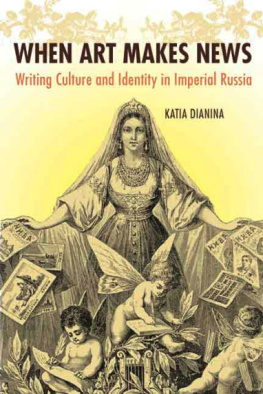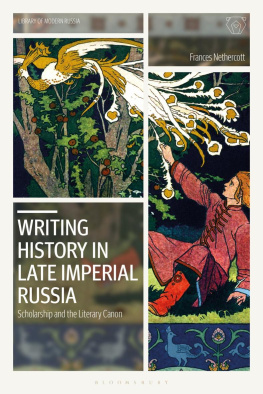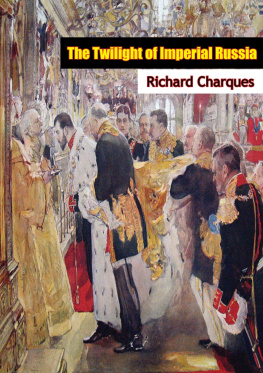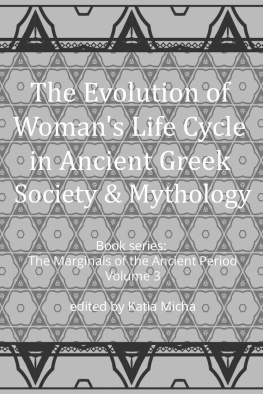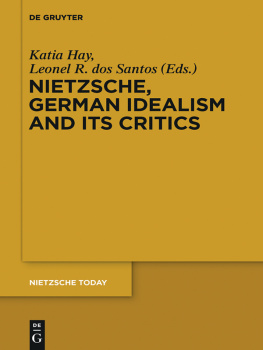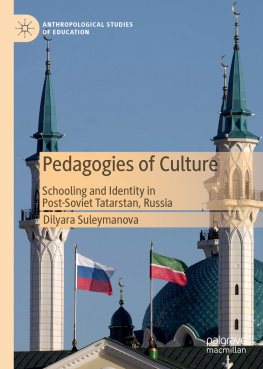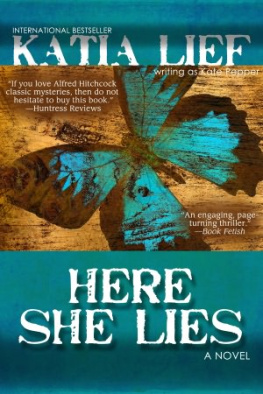2013 by Northern Illinois University Press
Published by the Northern Illinois University Press, DeKalb, Illinois 60115
Manufactured in the United States using acid-free paper
All Rights Reserved
Design by Shaun Allshouse
Library of Congress Cataloging-in-Publication Data
Dianina, Katia.
When art makes news : writing culture and identity in imperial Russia / Katia Dianina.
pages : illustrations ; cm
Includes bibliographical references and index.
ISBN 978-0-87580-460 6 (cloth) ISBN 978-1-60909-075-3 (e-book)
1. Nationalism and artRussiaHistory19th century. 2. Nationalism in art. 3. Art and societyRussiaHistory19th century. 4. Art, Russian19th centuryHistory and criticism. 5. RussiaCivilization18011917. 6. MuseumsRussiaHistory19th century. I. Title.
N6987.D53 2013
701.03094709034dc23
2012048217
To my Familyand the Firebird
Contents
The Talk of the Nation
Part I
National Culture : A Conceptual Reading
Whats in a Term
An Interdisciplinary Paradigm for the Study of Russian Culture
The Evolution of Cultural Discourse
A Crisis of Culture
Launching the Discourse: International Exhibitions and Russian Texts
The Great Exhibition and the Little One
Writing the Crystal Palace: Russian Readings and Misreadings
The Discovery of the Russian Style, circa 1851
The Russian School of Art at the International Exhibition, 1862
Art and Society: Gathering Culture, Writing Identity
Defining Russia Culturally: The National Question and Its Representations
The Museum Age in Russia
The Newspaper Boom of the 1860s
The Feuilleton, or Russian Culture Lite
Russian Art as Controversy
Part II
Institutions and Debates: Negotiating Art and Power
The Millennium Monument, 1862
The Imperial Hermitage
Narratives of the Academy of Fine Arts
The Russian Art World in the News: Painting and Controversy
Realism and Nationality: The Rise of a Russian Realist Aesthetics
Art in Motion: The Itinerant Exhibitions and the Tretiakov Gallery of Art
Art for the Public? The Russian Museum of Alexander III
Built out of Words: History and Stylization
Culture in the Russian Style
Moscow, the Seat of National Culture
A Festival of Public Activity: The Birth of the Historical Museum, 18721883
National Revival Writ Large: From a Cult of Antiquity to a Souvenir Identity
The Russian Cult of Antiquity
Reinventing Tradition in Abramtsevo, Talashkino, and Beyond
Tales of a National Revival: The Snow Maiden and Lefty
The Triumph of Berendeevka: The Making of Russian Souvenir Identity, Paris 1900
The World of Art in the News: Culture Wars at the Turn of the Century
This volume grew out of my obsession with Russian museums. The years I spent researching, writing, and editing were ones of discoveryboth scholarly and personalbut they were also a time in which this book on public discourse itself matured through dialogue with others: authors, colleagues, mentors, and friends. I was privileged to enjoy the guidance and support of many people and institutions; today I would like to thank those who offered me inspiration and critical insights, encouragement and recognition, words of wisdom and lessons in style: Susan Bean, Rosalind Polly Blakesley, Joseph Bradley, David Brandenberger, Jeffrey Brooks, Patricia Chaput, Christopher Ely, Caryl Emerson, Donald Fanger, Amy Farranto, David C. Fisher, Alison Hilton, Barbara E. Johnson, Janet Kennedy, Nathaniel Knight, Marcus C. Levitt, Louise McReynolds, Anne Odom, Wendy Salmond, Andreas Schnle, Richard Stites, Elizabeth Syrkin, William Mills Todd, III, and Richard Wortman. I gratefully acknowledge funding from an ACLS/SSRC/NEH International and Area Studies Fellowship, as well as a Faculty Travel Grant in International Studies and a Research Support Grant in the Arts, Humanities, and Social Sciences from the University of Virginia.
Parts of this volume appeared earlier in journal articles: The Feuilleton: An Everyday Guide to Public Culture in the Age of the Great Reforms, Slavic and East European Journal 47, no. 2 (2003); The Firebird of the National Imaginary: The Myth of Russian Culture and Its Discontents, The Journal of European Studies 42, no. 3 (2012); and Museum and Message: Writing Public Culture in Imperial Russia, Slavic and East European Journal 56, no. 2 (2012). Revised versions of these publications are used here with permission.
A Note on Translation and Transliteration
This study on popular perception of art relies heavily on ephemeral journalistic writing, much of which has never been translated. The stylistic peculiarity of the originals was purposefully preserved in order to accurately represent the volatile spirit of this evolving art criticism for the general reader. Unless otherwise noted, all translations are mine. I have primarily followed the Library of Congress transliteration system. For the sake of readability, Russian names ending in ii have been changed to y (Belinsky, Danilevsky); customary practice was observed in rendering names well known in English (Benois, Gogol). Bibliographical references adhere more strictly to the standard Library of Congress system.
The Talk of the Nation
A gain culture? Yes, culture again. I dont know anything else that can save our country from ruin, wrote Maxim Gorky in 1918. Culture as salvation and pride, faith and beautythe tradition of investing culture with special meaning has deep roots in Russia. It has survived the revolutions and wars of the twentieth century and remains one of the few constants of identity that the imperial, Soviet, and post-Soviet periods share. Culture is Russias secular religion: major national upheavals and everyday hardship notwithstanding, Russians devotion to culture has persisted through time. Boris Pilniak expressed it brilliantly: I love Russian culture, Russian historyno matter how absurdits originality, its awkwardness, its stove-benches ( lezhanki ) (you know, those with glazed tiles), its blind alleys; I love our Mussorgskian excess ( musorgsovshchina ). His passionate rhetoric is contagious: when dealing with a subject more appropriate for veneration than critical study, the audience understandably takes part in this emotionally charged discourse. The much-loved Russian canon includes Pushkin and Gogol, Dostoevsky and Tolstoy, Ostrovsky and Chekhov, Repin and Vasnetsov, the Hermitage and the Tretiakov Gallery, classical music and balalaika concerts, Tchaikovsky and Mussorgsky, folk songs and fairy tales, the Ballets Russes and the Mariinsky Theater, icons and matreshka dolls, the Firebird and Faberg. The list, inherently incomplete, goes on. How do individual works and institutions of art cohere into a long-standing tradition? When and how does culture become a marker of national affiliation?
A number of good surveys of Russian culture already exist, and several new studies on painting, architecture, and folk art in particular have recently appeared as well. For the most part, this book is not about literature or the history of the arts. Nor is it concerned with the familiar attribute of this cultureRussian Orthodoxya time-honored institution largely bypassed by debates on the emergent secular tradition during the imperial period. Instead, When Art Makes News focuses on art as a public event, describing and evaluating the complex impact the visual arts had on society and considering the origins of the Russian cult of culture. It seems that in a country where the writer is a second government and the museum is more than simply a museum, culture has always been the talk of the nationin salons, conference halls, or around kitchen tables. Many of its classical elements, however, date back only as far as the second half of the nineteenth century, a time that produced the core of images and texts currently associated with Russian heritage. This volume is about how this national tradition was written.

